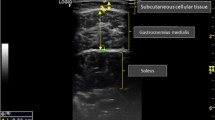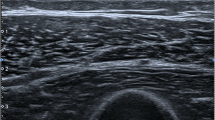Abstract
Objectives
We assessed muscle mass and function using ultrasound (US) and shear wave elastography (SWE) for sarcopenia in elderly patients with type 2 diabetes.
Methods
There were 84 patients with type 2 diabetes enrolled in this study; of these, 30 had sarcopenia and 54 did not. We measured appendicular skeletal muscle mass index (ASMI), handgrip strength, calf circumference, 6-m walking speed, and 5-time chair stand test. All patients were in the supine position with their knees in straight and bent poses in turn. The US-derived thickness (Tstraight, Tbent), cross-sectional area (CSAstraight, CSAbent), and SWE (SWEstraight, SWEbent) of the rectus femoris muscle (RFM) were measured and the differences (ΔT, ΔCSA, ΔSWE) were calculated. We assessed the correlations of clinical indicators with US and SWE features. We then compared the clinical indicators and US and SWE features between patients with and without sarcopenia to determine independent predictors. Diagnostic models were established based on these independent predictors.
Results
The ASMI was correlated with Tbent (r = 0.57, p < 0.001) and CSAbent (r = 0.50, p < 0.001). Handgrip strength was correlated with Tbent (r = 0.53, p < 0.001) and CSAbent (r = 0.51, p < 0.001). Between patients with and without sarcopenia, the indicators of age, ΔCSA, and ΔSWE were statically different (all p ≤ 0.001). Based on these results, a diagnostic model for sarcopenia was established with 83.3% sensitivity, 83.3% specificity, and 83.3% accuracy.
Conclusions
In elderly people with type 2 diabetes, sarcopenia patients had smaller muscle CSA and less stiffness than non-sarcopenia patients. US and SWE might be useful to screen them.
Key Points
• Sarcopenia is common in elderly people with type 2 diabetes.
• Ultrasound and shear wave elastography might be useful methods for quantitatively assessing muscle mass and strength.
• Ultrasound and shear wave elastography might be useful methods for screening sarcopenia in elderly patients with type 2 diabetes.




Similar content being viewed by others
Change history
12 April 2023
A Correction to this paper has been published: https://doi.org/10.1007/s00330-023-09570-8
Abbreviations
- ASMI:
-
Appendicular skeletal muscle index
- BMI:
-
Body mass index
- CSA:
-
Cross-sectional area
- CSAbent :
-
The cross-sectional area of the mid-portion of rectus femoris muscle when patients were in the supine position with their knees in the bent pose
- CSAstraight :
-
The cross-sectional area of the mid-portion of rectus femoris muscle when patients were in the supine position with their knees in the straight pose
- RFM:
-
Rectus femoris muscle
- SWE:
-
Shear wave elastography
- SWEbent :
-
The mean value of shear wave elastography of the mid-portion of rectus femoris muscle when patients were in the supine position with their knees in the bent pose
- SWEstraight :
-
The mean value of shear wave elastography of the mid-portion of rectus femoris muscle when patients were in the supine position with their knees in the straight pose
- T:
-
Thickness
- Tbent :
-
The thickness of the mid-portion of rectus femoris muscle when patients were in the supine position with their knees in the bent pose
- Tstraight :
-
The thickness of the mid-portion of rectus femoris muscle when patients were in the supine position with their knees in the straight pose
- US:
-
Ultrasound
- ΔCSA:
-
The difference between CSAbent and CSAstraight
- ΔSWE:
-
The difference between SWEbent and SWEbent
- ΔT:
-
The difference between Tbent and Tstraight
References
Chen LK, Woo J, Assantachai P et al (2020) Asian Working Group for Sarcopenia: 2019 consensus update on sarcopenia diagnosis and treatment. J Am Med Dir Assoc 21(3):300–307.e2
Miljkovic N, Lim JY, Miljkovic I, Frontera WR (2015) Aging of skeletal muscle fibers. Ann Rehabil Med 39(2):155–162
Janssen I, Shepard DS, Katzmarzyk PT, Roubenoff R (2004) The healthcare costs of sarcopenia in the United States. J Am Geriatr Soc 52(1):80–85
Buford TW, Anton SD, Judge AR et al (2010) Models of accelerated sarcopenia: critical pieces for solving the puzzle of age-related muscle atrophy. Ageing Res Rev 9(4):369–83.10
Arango-Lopera VE, Arroyo P, Gutiérrez-Robledo LM, Pérez-Zepeda MU, Cesari M (2013) Mortality as an adverse outcome of sarcopenia. J Nutr Health Aging 17(3):259–262
Leenders M, Verdijk LB, van der Hoeven L et al (2013) Patients with type 2 diabetes show a greater decline in muscle mass, muscle strength, and functional capacity with aging. J Am Med Dir Assoc 14(8):585–592
Albano D, Messina C, Vitale J, Sconfienza LM (2020) Imaging of sarcopenia: old evidence and new insights. Eur Radiol 30(4):2199–2208
Rustani K, Kundisova L, Capecchi PL, Nante N, Bicchi M (2019) Ultrasound measurement of rectus femoris muscle thickness as a quick screening test for sarcopenia assessment. Arch Gerontol Geriatr 83:151–154
Scott JM, Martin DS, Ploutz-Snyder R et al (2017) Panoramic ultrasound: a novel and valid tool for monitoring change in muscle mass. J Cachexia Sarcopenia Muscle 8(3):475–481
Şendur HN, Cindil E, Cerit MN, Kılıç P, Gültekin Iİ, Oktar SÖ (2020) Evaluation of effects of aging on skeletal muscle elasticity using shear wave elastography. Eur J Radiol 128:109038
Chu CA, Chen YJ, Chang KV, Wu WT, Özçakar L (2021) Reliability of sonoelastography measurement of tongue muscles and its application on obstructive sleep apnea. Front Physiol 12:654667
Hsu PC, Chang KV, Wu WT, Wang JC, Özçakar L (2021) Effects of ultrasound-guided peritendinous and intrabursal corticosteroid injections on shoulder tendon elasticity: a post hoc analysis of a randomized controlled trial. Arch Phys Med Rehabil 102(5):905–913
Koo TK, Guo JY, Cohen JH, Parker KJ (2013) Relationship between shear elastic modulus and passive muscle force: an ex-vivo study. J Biomech 46(12):2053–2059
Liu X, Yu HK, Sheng SY et al (2021) Quantitative evaluation of passive muscle stiffness by shear wave elastography in healthy individuals of different ages. Eur Radiol 31(5):3187–3194
Kim KS, Park KS, Kim MJ, Kim SK, Cho YW, Park SW (2014) Type 2 diabetes is associated with low muscle mass in older adults. Geriatr Gerontol Int 14(Suppl 1):115–121
Narici M, McPhee J, Conte M et al (2021) Age-related alterations in muscle architecture are a signature of sarcopenia: the ultrasound sarcopenia index. J Cachexia Sarcopenia Muscle 12(4):973–982
Miyamoto N, Hirata K, Kanehisa H, Yoshitake Y (2015) Validity of measurement of shear modulus by ultrasound shear wave elastography in human pennate muscle. PLoS One 10(4):e0124311
Alfuraih AM, Tan AL, O'Connor P, Emery P, Wakefield RJ (2019) The effect of ageing on shear wave elastography muscle stiffness in adults. Aging Clin Exp Res 31(12):1755–1763
Faulkner JA, Larkin LM, Claflin DR, Brooks SV (2007) Age-related changes in the structure and function of skeletal muscles. Clin Exp Pharmacol Physiol 34(11):1091–1096
Choi Y, Im S, Park GY (2021) Ultrasound evaluation of the rectus femoris for sarcopenia in patients with early subacute stroke. J Clin Med 10(14):3010
Berger J, Bunout D, Barrera G et al (2015) Rectus femoris (RF) ultrasound for the assessment of muscle mass in older people. Arch Gerontol Geriatr 61(1):33–38
Matsuzawa R, Yamamoto S, Suzuki Y et al (2021) The clinical applicability of ultrasound technique for diagnosis of sarcopenia in hemodialysis patients. Clin Nutr 40(3):1161–1167
Giambini H, Hatta T, Rezaei A, An K (2018) Extensibility of the supraspinatus muscle can be predicted by combining shear wave elastography and magnetic resonance imaging-measured quantitative metrics of stiffness and volumetric fat infiltration: a cadaveric study. Clin Biomech (Bristol, Avon) 57:144–149
Kragstrup TW, Kjaer M, Mackey AL (2011) Structural, biochemical, cellular, and functional changes in skeletal muscle extracellular matrix with aging. Scand J Med Sci Sports 21(6):749–757
Xu J, Fu SN, Hug F (2021) Age-related increase in muscle stiffness is muscle length dependent and associated with muscle force in senior females. BMC Musculoskelet Disord 22(1):829
Maïsetti O, Hug F, Bouillard K, Nordez A (2012) Characterization of passive elastic properties of the human medial gastrocnemius muscle belly using supersonic shear imaging. J Biomech 45(6):978–984
Rodrigues CJ, Rodrigues Junior AJ (2000) A comparative study of aging of the elastic fiber system of the diaphragm and the rectus abdominis muscles in rats. Braz J Med Biol Res 33(12):1449–1454
Nies I, Ackermans LLGC, Poeze M, Blokhuis TJ, Ten Bosch JA (2022) The diagnostic value of ultrasound of the rectus femoris for the diagnosis of sarcopenia in adults: a systematic review. Injury S0020-1383(22)00412-0.
Chen YL, Liu PT, Chiang HK et al (2021) Ultrasound measurement of rectus femoris muscle parameters for discriminating sarcopenia in community-dwelling adults. J Ultrasound Med 41:2269–2277
Barotsis N, Galata A, Hadjiconstanti A, Panayiotakis G (2020) The ultrasonographic measurement of muscle thickness in sarcopenia. A prediction study. Eur J Phys Rehabil Med 56(4):427–437
Deng M, Zhou X, Li Y et al (2022) Ultrasonic elastography of the rectus femoris, a potential tool to predict sarcopenia in patients with chronic obstructive pulmonary disease. Front Physiol 12:783421
Abe T, Loenneke JP, Thiebaud RS, Fukunaga T (2014) Age-related site-specific muscle wasting of upper and lower extremities and trunk in Japanese men and women. Age (Dordr) 36(2):813–821
Smerilli G, Cipolletta E, Tanimura S et al (2021) Ultrasound measurement of muscle thickness at the anterior thigh level in rheumatology setting: a reliability study. Clin Rheumatol 40(3):1055–1060
Nijholt W, Scafoglieri A, Jager-Wittenaar H, Hobbelen JSM, van der Schans CP (2017) The reliability and validity of ultrasound to quantify muscles in older adults: a systematic review. J Cachexia Sarcopenia Muscle 8(5):702–712
Strasser EM, Draskovits T, Praschak M, Quittan M, Graf A (2013) Association between ultrasound measurements of muscle thickness, pennation angle, echogenicity and skeletal muscle strength in the elderly. Age (Dordr) 35(6):2377–2388
Minetto MA, Caresio C, Menapace T et al (2016) Ultrasound-based detection of low muscle mass for diagnosis of sarcopenia in older adults. PM R 8(5):453–462
Ramírez-Fuentes C, Mínguez-Blasco P, Ostiz F et al (2019) Ultrasound assessment of rectus femoris muscle in rehabilitation patients with chronic obstructive pulmonary disease screened for sarcopenia: correlation of muscle size with quadriceps strength and fat-free mass. Eur Geriatr Med 10(1):89–97
Seymour JM, Ward K, Sidhu PS et al (2009) Ultrasound measurement of rectus femoris cross-sectional area and the relationship with quadriceps strength in COPD. Thorax 64(5):418–423
Funding
This study has received funding from the National Natural Science Foundation of China, Grant/Award Numbers: 82151318, 81927801, 82072092, 81901753, 82001816; Fundamental Research Funds for the Central Universities, Grant/Award Number: 22120190213; Shanghai Municipal Health Commission, Grant/Award Numbers: 2019LJ21, SHSLCZDZK03502; Science and Technology Commission of Shanghai Municipality, Grant/Award Numbers: 19441903200, 19DZ2251100.
Author information
Authors and Affiliations
Corresponding authors
Ethics declarations
Guarantor
The scientific guarantor of this publication is Le-Hang Guo.
Conflict of Interest
The authors of this manuscript declare no relationships with any companies whose products or services may be related to the subject matter of the article.
Statistics and Biometry
No complex statistical methods were necessary for this paper.
Informed Consent
Written informed consent was obtained from all subjects (patients) in this study.
Ethical Approval
Institutional Review Board approval was obtained.
Methodology
• prospective
• diagnostic study
• performed at one institution
Additional information
Publisher’s note
Springer Nature remains neutral with regard to jurisdictional claims in published maps and institutional affiliations.
Affiliation number 4 has been added and the affiliations of all authors have been corrected.
Rights and permissions
Springer Nature or its licensor (e.g. a society or other partner) holds exclusive rights to this article under a publishing agreement with the author(s) or other rightsholder(s); author self-archiving of the accepted manuscript version of this article is solely governed by the terms of such publishing agreement and applicable law.
About this article
Cite this article
Chen, ZT., Jin, FS., Guo, LH. et al. Value of conventional ultrasound and shear wave elastography in the assessment of muscle mass and function in elderly people with type 2 diabetes. Eur Radiol 33, 4007–4015 (2023). https://doi.org/10.1007/s00330-022-09382-2
Received:
Revised:
Accepted:
Published:
Issue Date:
DOI: https://doi.org/10.1007/s00330-022-09382-2




